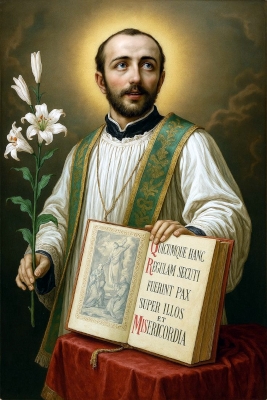Lives of the Saints
Our Models and Protectors
Spiritual Bouquet:
July 5

Saint Anthony Maria
Zaccaria
Founder
(1502-1539)
Saint Anthony Maria Zaccaria was born at Cremona, Italy, in 1502, of noble parents. His father died when very young, and his eighteen-year-old mother was left to bring up her only son in the love of God and tenderness for the poor. As a child he gave his coat to a poor beggar who was shivering with cold. He studied philosophy and medicine at the Universities of Pavia and Padua and became a licensed physician in 1524, but was striving more earnestly to care for souls than to heal their material envelope. Sometimes when he was traveling as a doctor and found abandoned children, he assembled them to teach them their Christian duties. He desired a more perfect life and wider possibilities for the apostolate of a Christian. He therefore studied theology, and was twenty-six years old when ordained in 1528.
Those present at the first Mass of Saint Anthony Maria saw him surrounded with an extraordinary light and a crown of Angels. He himself seemed to be an Angel on earth. By his preaching and example, Cremona was renewed, and then the young apostle went to Milan. To remedy disorders of every kind resulting from the war, he founded there the Order of Regular Clerics of Saint Paul, since called Barnabites because they were entrusted with the church of Saint Barnabas. He had a great devotion to Saint Paul and desired that his religious imitate the glorious Apostle. He also established a community of Sisters, called the Angelicals, and a confraternity for fathers of families. He animated all of his followers with his great love for God.
Despite opposition of various kinds, in 1532 the Constitutions of his two communities were approved by Pope Clement VII. Their founder defended his religious with persevering gentleness in all the difficulties they encountered, and recommended to them to spend their free moments in conversation with Jesus crucified. God favored him with exceptional gifts; he read in hearts and saw the future. He died when only 36 years old, in 1539, and was canonized by Pope Leo XIII in 1897.
Le Calendrier catholique, by Calvet and Martin